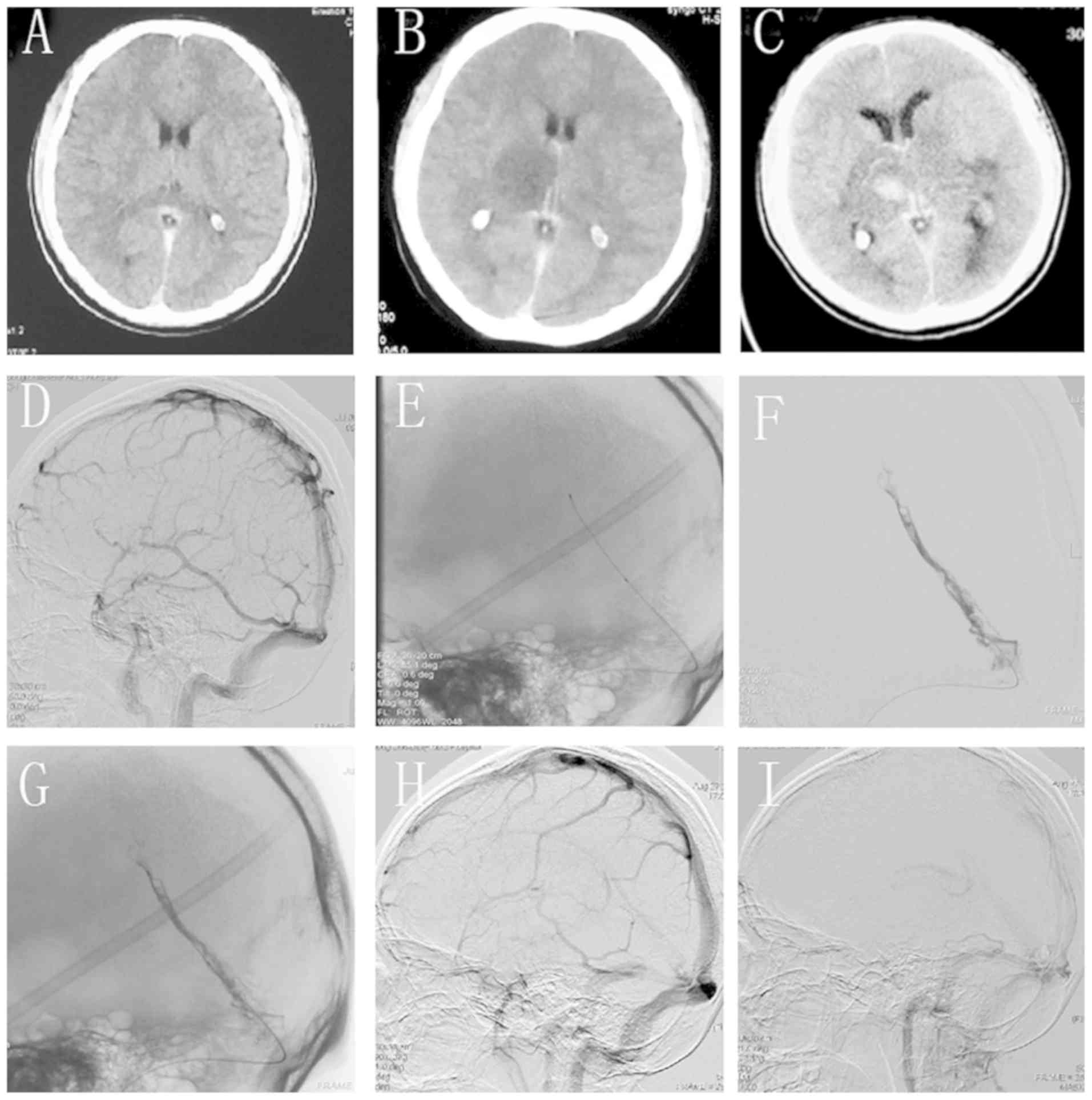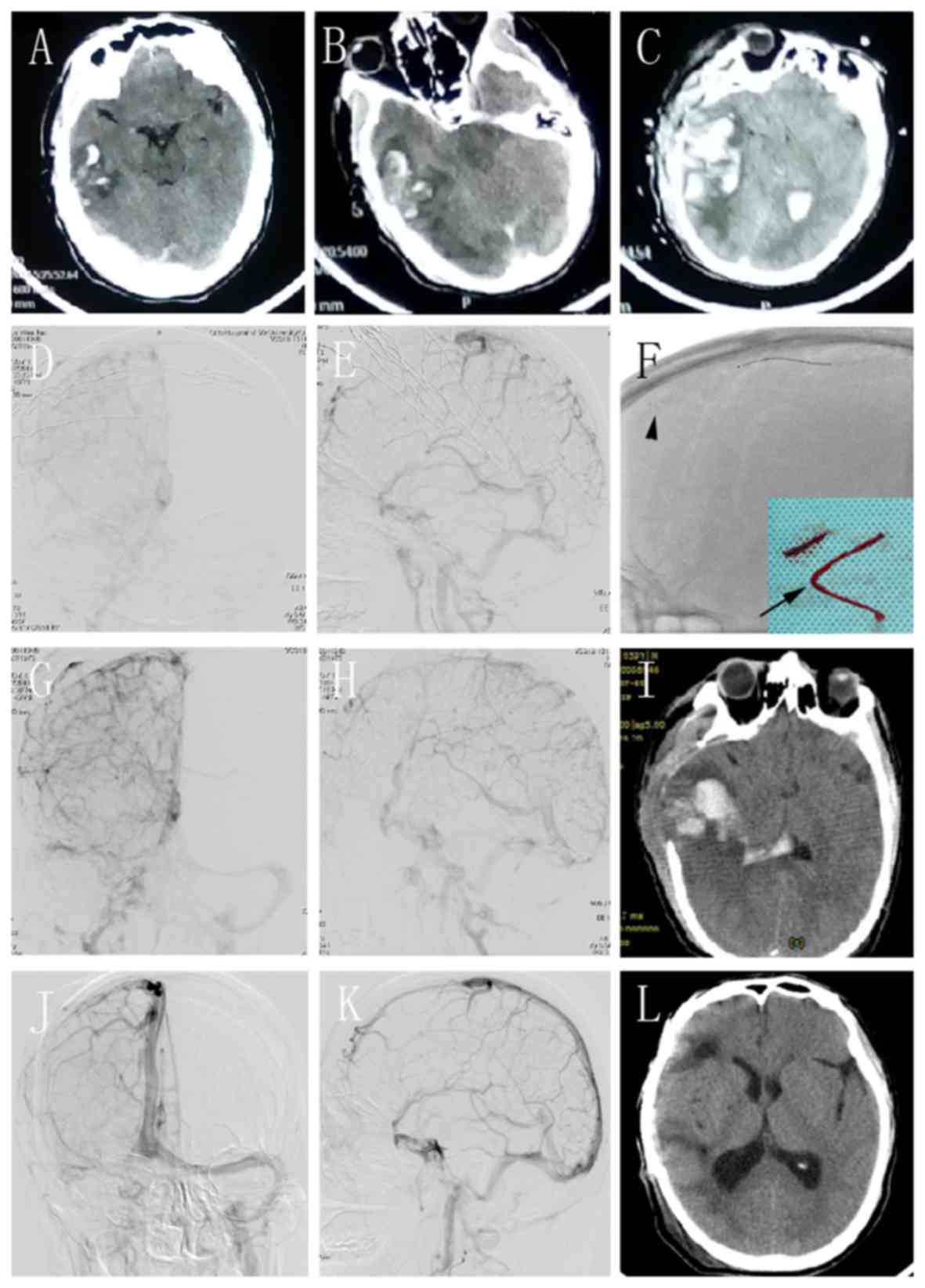|
1
|
Silvis SM, de Sousa DA, Ferro JM and
Coutinho JM: Cerebral venous thrombosis. Nat Rev Neurol.
13:555–565. 2017.PubMed/NCBI View Article : Google Scholar
|
|
2
|
Linn J, Ertl-Wagner B, Seelos KC, Strupp
M, Reiser M, Bruckmann H and Brüning R: Diagnostic value of
multidetector-row CT angiography in the evaluation of thrombosis of
the cerebral venous sinuses. AJNR Am J Neuroradiol. 28:946–952.
2007.PubMed/NCBI
|
|
3
|
Saposnik G, Barinagarrementeria F, Brown
RD Jr, Bushnell CD, Cucchiara B, Cushman M, deVeber G, Ferro JM and
Tsai FY: American Heart Association Stroke Council and the Council
on Epidemiology and Prevention: Diagnosis and management of
cerebral venous thrombosis: A statement for healthcare
professionals from the American Heart Association/American Stroke
Association. Stroke. 42:1158–1192. 2011.
|
|
4
|
Leach JL, Fortuna RB, Jones BV and
Gaskill-Shipley MF: Imaging of cerebral venous thrombosis: Current
techniques, spectrum of findings, and diagnostic pitfalls.
Radiographics. 26 (Suppl 1):S19–S43. 2006.PubMed/NCBI View Article : Google Scholar
|
|
5
|
Nasr DM, Brinjikji W, Cloft HJ, Saposnik G
and Rabinstein AA: Mortality in cerebral venous thrombosis: Results
from the national inpatient sample database. Cerebrovasc Dis.
35:40–44. 2013.PubMed/NCBI View Article : Google Scholar
|
|
6
|
Capecchi M, Abbattista M and Martinelli I:
Cerebral venous sinus thrombosis. J Thromb Haemost. 16:1918–1931.
2018.PubMed/NCBI View Article : Google Scholar
|
|
7
|
Ilyas A, Chen CJ, Raper DM, Ding D, Buell
T, Mastorakos P and Liu KC: Endovascular mechanical thrombectomy
for cerebral venous sinus thrombosis: A systematic review. J
Neurointerv Surg. 9:1086–1092. 2017.PubMed/NCBI View Article : Google Scholar
|
|
8
|
Styczen H, Tsogkas I, Liman J, Maus V and
Psychogios MN: Endovascular mechanical thrombectomy for cerebral
venous sinus thrombosis: A single-center experience. World
Neurosurg. 127:e1097–e1103. 2019.PubMed/NCBI View Article : Google Scholar
|
|
9
|
Mokin M, Lopes DK, Binning MJ,
Veznedaroglu E, Liebman KM, Arthur AS, Doss VT, Levy EI and
Siddiqui AH: Endovascular treatment of cerebral venous thrombosis:
Contemporary multicenter experience. Interv Neuroradiol.
21:520–526. 2015.PubMed/NCBI View Article : Google Scholar
|
|
10
|
Mortimer AM, Bradley MD, O'Leary S and
Renowden SA: Endovascular treatment of children with cerebral
venous sinus thrombosis: A case series. Pediatric Neurol.
49:305–312. 2013.PubMed/NCBI View Article : Google Scholar
|
|
11
|
Kulcsár Z, Marosfoi M, Berentei Z and
Szikora I: Continuous thrombolysis and repeated thrombectomy with
the Penumbra System in a child with hemorrhagic sinus thrombosis:
Technical note. Acta Neurochir (Wien). 152:911–916. 2010.PubMed/NCBI View Article : Google Scholar
|
|
12
|
Guo XB, Song LJ and Guan S: Endovascular
treatment of chronic, recurrent headache secondary to chronic
cerebral venous sinus thrombosis. J Stroke Cerebrovasc Dis.
23:560–563. 2014.PubMed/NCBI View Article : Google Scholar
|
|
13
|
Chen C, Li X, Huang L, Zhang J, Chen S, Ye
H, Ye Q, Zhang T, Zhang X, Chen Z, et al: Mechanical thrombectomy
with intraoperative local thrombolysis versus mechanical
thrombectomy with continuous thrombolysis for treatment of cerebral
venous sinus thrombosis: A systematic review of 82 cases. World
Neurosurg. 125:489–497.e14. 2019.PubMed/NCBI View Article : Google Scholar
|
|
14
|
Chen C, Wang Q, Li X, Lu Z, He J, Fang Q,
Ke X, Duan C and Li T: Stent retriever thrombectomy combined with
local thrombolytic therapy for cerebral venous sinus thrombosis: A
case report. Exp Ther Med. 14:3961–3970. 2017.PubMed/NCBI View Article : Google Scholar
|
|
15
|
Coutinho JM, Zuurbier SM, Aramideh M and
Stam J: The incidence of cerebral venous thrombosis: A
cross-sectional study. Stroke. 43:3375–3377. 2012.PubMed/NCBI View Article : Google Scholar
|
|
16
|
Dmytriw AA, Song JSA, Yu E and Poon CS:
Cerebral venous thrombosis: State of the art diagnosis and
management. Neuroradiology. 60:669–685. 2018.PubMed/NCBI View Article : Google Scholar
|
|
17
|
Ferro JM, Bousser MG, Canhao P, Coutinho
JM, Crassard I, Dentali F, di Minno M, Maino A, Martinelli I,
Masuhr F, et al: European Stroke Organization guideline for the
diagnosis and treatment of cerebral venous thrombosis-endorsed by
the European Academy of Neurology. Eur J Neurol. 24:1203–1213.
2017.PubMed/NCBI View Article : Google Scholar
|
|
18
|
Viegas LD, Stolz E, Canhão P and Ferro JM:
Systemic thrombolysis or cerebral venous and dural sinus
thrombosis: A systematic review. Cerebrovasc Dis. 37:43–50.
2014.PubMed/NCBI View Article : Google Scholar
|
|
19
|
Gala NB, Agarwal N, Barrese J, Gandhi CD
and Prestigiacomo CJ: Current endovascular treatment options of
dural venous sinus thrombosis: A review of the literature. J
Neurointerv Surg. 5:28–34. 2013.PubMed/NCBI View Article : Google Scholar
|
|
20
|
Guo XB, Guan S, Fan Y and Song LJ: Local
thrombolysis for severe cerebral venous sinus thrombosis. AJNR Am J
Neuroradiol. 33:1187–1190. 2012.PubMed/NCBI View Article : Google Scholar
|
|
21
|
Goyal M, Menon BK, van Zwam WH, Dippel DW,
Mitchell PJ, Demchuk AM, Dávalos A, Majoie CB, van der Lugt A, de
Miquel MA, et al: Endovascular thrombectomy after large-vessel
ischaemic stroke: A meta-analysis of individual patient data from
five randomised trials. Lancet. 387:1723–1731. 2016.PubMed/NCBI View Article : Google Scholar
|
|
22
|
Li G, Zeng X, Hussain M, Meng R, Liu Y,
Yuan K, Sikharam C, Ding Y, Ling F and Ji X: Safety and validity of
mechanical thrombectomy and thrombolysis on severe cerebral venous
sinus thrombosis. Neurosurgery. 72:730–738. 2013.PubMed/NCBI View Article : Google Scholar
|
|
23
|
Chow K, Gobin YP, Saver J, Kidwell C, Dong
P and Viñuela F: Endovascular treatment of dural sinus thrombosis
with rheolytic thrombectomy and intra-arterial thrombolysis.
Stroke. 31:1420–1425. 2000.PubMed/NCBI View Article : Google Scholar
|
|
24
|
Blackham KA: Extensive dural sinus
thrombosis: Successful recanalization with thrombolysis and a novel
thrombectomy device. J Neurosurg. 114:133–135. 2011.PubMed/NCBI View Article : Google Scholar
|
|
25
|
Curtin KR, Shaibani A, Resnick SA, Russell
EJ and Simuni T: Rheolytic catheter thrombectomy, balloon
angioplasty, and direct recombinant tissue plasminogen activator
thrombolysis of dural sinus thrombosis with preexisting hemorrhagic
infarctions. AJNR Am J Neuroradiol. 25:1807–1811. 2004.PubMed/NCBI
|
|
26
|
Dowd CF, Malek AM, Phatouros CC and
Hemphill JC III: Application of a rheolytic thrombectomy device in
the treatment of dural sinus thrombosis: A new technique. AJNR Am J
Neuroradiol. 20:568–570. 1999.PubMed/NCBI
|
|
27
|
Chen H, He X, Xie G, Liang J, Ye Y, Deng
W, He Z, Liu D, Li D, Liu X and Fan Z: Cardiovascular magnetic
resonance black-blood thrombus imaging for the diagnosis of acute
deep vein thrombosis at 1.5 Tesla. J Cardiovasc Magn Reson.
20(42)2018.PubMed/NCBI View Article : Google Scholar
|
|
28
|
Siddiqui FM, Dandapat S, Banerjee C,
Zuurbier SM, Johnson M, Stam J and Coutinho JM: Mechanical
thrombectomy in cerebral venous thrombosis: Systematic review of
185 cases. Stroke. 46:1263–1268. 2015.PubMed/NCBI View Article : Google Scholar
|
|
29
|
Scott JA, Pascuzzi RM, Hall PV and Becker
GJ: Treatment of dural sinus thrombosis with local urokinase
infusion. Case report. J Neurosurg. 68:284–287. 1988.PubMed/NCBI View Article : Google Scholar
|
|
30
|
Canhao P, Falcao F and Ferro JM:
Thrombolytics for cerebral sinus thrombosis: A systematic review.
Cerebrovasc Dis. 15:159–166. 2003.PubMed/NCBI View Article : Google Scholar
|
|
31
|
D'Alise MD, Fichtel F and Horowitz M:
Sagittal sinus thrombosis following minor head injury treated with
continuous urokinase infusion. Surg Neurol. 49:430–435.
1998.PubMed/NCBI View Article : Google Scholar
|
|
32
|
Poon CS, Chang JK, Swarnkar A, Johnson MH
and Wasenko J: Radiologic diagnosis of cerebral venous thrombosis:
Pictorial review. AJR Am J Roentgenol. 189 (6 Suppl):S64–S75.
2007.PubMed/NCBI View Article : Google Scholar
|
|
33
|
Zuurbier SM, Coutinho JM, Majoie CB, Coert
BA, van den Munckhof P and Stam JJ: Decompressive hemicraniectomy
in severe cerebral venous thrombosis: A prospective case series.
Neurol. 259:1099–1105. 2012.PubMed/NCBI View Article : Google Scholar
|
















